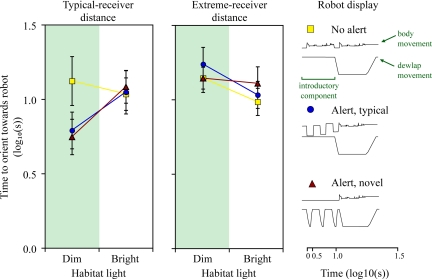Fig. 2.
Latency for A. gundlachi to orient toward robot displays with or without exaggerated introductory movements given at distances typical of most receivers and extreme for receivers (typical receiver distances: “no alert” in which the species-typical display is repeated, n = 53; “alert, typical”, 4-legged pushups are placed at the start of the species-typical display, n = 53; “alert, novel” an artificial alert created by the addition of rapid dewlaps to the start of the species-typical display, n = 52; extreme receiver distances: “no alert” n = 59; “alert, typical” n = 57; “alert, novel” n = 56). Plots show mean ± 1 SE orientation times for lizards in poor (“dim”) and bright light conditions (see Figs. S4 and S5). The displays performed by the robot are illustrated as display-action-pattern graphs depicting the movement of the body (upper line) and dewlap (lower line) over time. Robot displays are also shown in Movies S3, Movie S4, and Movie S5.

